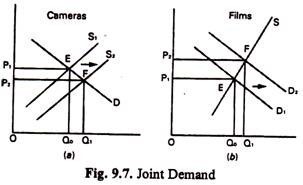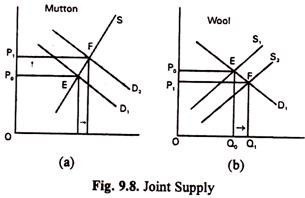Let us make an in-depth study of the joint demand and joint supply.
(a) Joint Demand:
Sometimes two commodities are demanded jointly. In such cases, a change in the supply of one will affect the price of the other. If the two commodities are complements—like cameras and films—an increase in the supply of one will lead to a rise in the price of the other.
Suppose there is a technological progress in the camera industry. This will lead to an increase in the supply of and a fall in the price of cameras. So the demand for cameras will increase. This will lead to an automatic increase in the demand for films. The end result is a rise in the market price of films. This interrelationship of demand is shown in the Fig. 9.7.
Fig. 9.8(a) shows that when the supply curve of cameras shifts to the right its price falls from P0 to P1. So a larger quantity of the commodity is now purchased. Thus, there is a movement along the same demand curve from point E and F in the event of a rightward shift on the demand curve. This means that an increase in supply first leads to a fall in price and fall in price ultimately leads to an increase in the quantity demanded for cameras.
ADVERTISEMENTS:
Fig. 9.8(b) shows that when the demand curve of films shifts to the right its price rises from P0 to P1. Then there is a movement along the same supply curve from point E to F in the event of a rightward shift of the demand curve. This means that the supply of a product (viz., an increase in and a fall in the price of cameras), will ultimately lead to an increase in demand for and a rise in the price of the product which is jointly demanded (viz., films).
(b) Joint Supply:
Sometimes the production process is such that two commodities are supplied jointly—such as mutton and wool. An increase in the supply of mutton implies an automatic increase in the supply of wool. Now, in case of such items which are jointly supplied an increase in the supply of one will lead to a fall in the price of the other. Suppose the demand for mutton increases.
This will lead to an increase in the production of mutton. There will be rightward shift of the demand curve of mutton but movement (from right to left) along the same demand curve, as Fig. 9.8(a) shows. However, an increase in the supply of mutton will automatically increase the supply of wool. This means that the supply curve of wool will now shift to the right. Consequently, the price of wool will fall. In fact, the price of wool has to be reduced to sell the additional wool that has been produced.
ADVERTISEMENTS:
In this case there is rightward shift of the supply curve of wool but movement (from left to right) along the same demand curve for wool. Fig. 9.8(a) shows that in case of mutton price change and quantity change are in the same direction. But Fig. 9.8(b) shows that in case of wool price change and quantity change are in the opposite direction. While in case of mutton an increase in demand leads to an increase in price, in case of wool an increase in supply leads to a fall in price.

